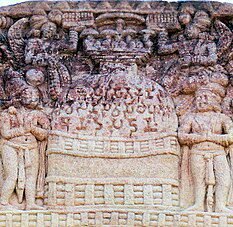Sanchi Stupa: A Journey Through India’s Rich Buddhist Past

One of the most renowned and iconic buildings in Buddhist architecture is the Sanchi Stupa, which is situated in Madhya Pradesh, India. This historic location, which is set on a hill in Sanchi, is a spiritual emblem that symbolizes the long tradition of Buddhism in India in addition to being a work of architectural wonder. Scholars, pilgrims, and tourists from all over the world are drawn to it by its exquisite domed structure and detailed carvings.

Origin of the Sanchi Stupa
The famous Mauryan emperor Ashoka, who ruled in the 3rd century BCE, is credited with creating the Sanchi Stupa. Following the brutal Kalinga conflict, Ashoka converted to Buddhism and accepted its principles of non-violence and peace, eventually becoming one of the religion’s patrons. Building stupas throughout his empire was one of his numerous initiatives to spread Buddhist principles, and Sanchi emerged as one of the most important locations selected for this purpose.

The original structure of the Great Stupa at Sanchi (also known as Stupa No. 1) was built around the 3rd century BC during Ashoka’s reign. Large bricks and mud mortar were used to build the original Ashokan stupa, which was about half the size of its spectacular structure today. Initially, it was a much smaller, simpler structure, comprising a hemispherical brick mound that enshrined sacred relics of the Buddha. Over time, however, the stupa grew in scale and grandeur, with later additions of intricately carved gateways and railings. Sanchi, along with other Buddhist sites, became a place of pilgrimage and veneration, symbolizing the spread of Buddhist teachings in ancient India.

History
The Sanchi Stupa’s history spans over several centuries, evolving with the passage of time and the influence of different dynasties. After the original construction by Ashoka, the stupa underwent significant modifications during the Shunga dynasty in 2nd century BC. The Sanchi Stupa was expanded by the Shunga emperors, who also added the exquisitely carved pieces. The stupa was also covered in stone. Torans (gateways) were installed in Sanchi in the 1st century BC, during the Satavahana reign. These torans became emblematic of Buddhist art and storytelling because of their finely carved representations of the Jataka tales, which are accounts of the Buddha’s past lives.

But with the rise of Hinduism and the gradual decline of Buddhism in India, Sanchi, like many other sacred sites, fell into obscurity. The stupas disappeared for centuries after the site was largely abandoned in the 13th century. Sanchi was not discovered until the early 1800s, when British commanders went on an expedition to India. Soon after, efforts began to preserve, restore this beautiful site. The current location of Sanchi was rediscovered and renovated in 1919 by Sir John Hubert Marshall, the Indian Archaeological Survey’s Director-General at the time.

Significance
Sanchi Stupa has religious and historical significance. It is one of the oldest and best-preserved stupas in India and a symbol of the continuing influence of Buddhism in the Indian subcontinent. According to Buddhist cosmology, the building itself symbolizes the world mountain or the mound of earth. Its main purpose is to house the relics of Buddha or saints, which is why religious people around the world consider it a very sacred place.

Every component of the stupa has a symbolic value. The dharma, or eternal law of the universe, is symbolized by the hemispherical dome. The axis mundi, or the connection between the earth and the heavens, is represented by the central pillar, or Yasti. The stupa’s three-tiered umbrella structure stands for the Dharma (teachings), the Sangha (community), and the Buddha—the Three Jewels of Buddhism. When combined, these components turn the stupa into a cosmic diagram that represents the enlightenment path and the Buddha’s teachings.

The Sanchi Stupa is a work of art and architecture in addition to having religious significance. The most exquisite specimens of ancient Indian sculpture can be found on the gateway sculptures, which portray scenes from the Jataka tales and the life of the Buddha. The stupa is transformed into a living manual of Buddhist ideals by these reliefs, which are not only aesthetically magnificent but also tell significant stories of moral and spiritual lessons.
Current Situation of Sanchi Stupa
The Sanchi Stupa is now a UNESCO World Heritage Site due to its historical, cultural, and architectural significance. It is one of the most studied and best-preserved sites in India, attracting thousands of tourists each year. The Indian government has taken great care to preserve the integrity of the site, working with international organisations such as UNESCO to ensure that the site remains a tourist destination and a repository of information for historians and archaeologists.

The stupa is a symbol of India’s rich religious history and a testament to the country’s pride in its long heritage. Today, Sanchi is not only a reminder of the past but also a tourist destination, offering visitors a number of attractions, including museums housing a number of artifacts including sculptures, manuscripts, and art. Despite these plans, however, the stupa is still vulnerable to environmental damage and therefore requires constant protection from weathering and human activity.
Preservation Efforts
Many collaborative efforts of governments, historical and international organisations have come together to preserve the Sanchi stupa and its surrounding buildings. Restoration of the site began in the 19th century under British colonial rule. Much of the early restoration work was done by British archaeologist Sir John Marshall, who was the Director general of the Archaeological Survey of India (ASI), who began excavations and digs at Sanchi in the early 20th century.

In 1989, Sanchi was declared a UNESCO World Heritage Site and international support for its preservation was further strengthened. UNESCO played a major role in aiding and funding to ensure the preservation of the Sanchi Stupa for future generations. The stupa has been carefully restored using modern technology to preserve and reduce the effects of extreme weather conditions. Conservation efforts include regular maintenance of the stone structures, stabilization of the toranas and management of tourists to prevent damage to the ancient monuments.
Conclusion
The Sanchi Stupa is a monumental example of India’s rich religious and cultural legacy. From its modest origins as a simple brick building constructed by Ashoka, it has developed into an architectural wonder that perfectly captures the essence and precepts of Buddhism. Travelers from all over the world are still drawn to the stupa by its aesthetic appeal, historical relevance, and spiritual significance. It is not also a tourist favourite but it is also something people interested in history and archaeology like to look into.


